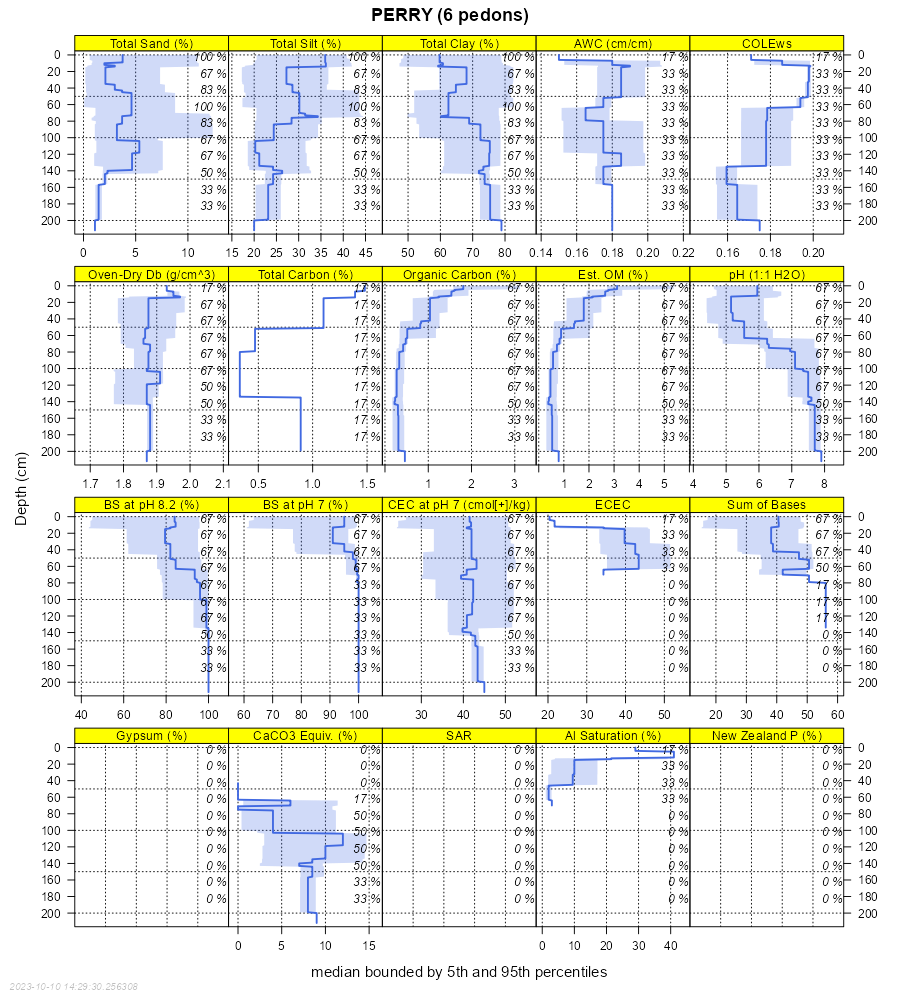Lab Data Summary
Aggregate lab data for the PERRY soil series. This aggregation is based on all pedons with a current taxon name of PERRY, and applied along 1-cm thick depth slices. Solid lines are the slice-wise median, bounded on either side by the interval defined by the slice-wise 5th and 95th percentiles. The median is the value that splits the data in half. Five percent of the data are less than the 5th percentile, and five percent of the data are greater than the 95th percentile. Values along the right hand side y-axis describe the proportion of pedon data that contribute to aggregate values at this depth. For example, a value of "90%" at 25cm means that 90% of the pedons correlated to PERRY were used in the calculation. Source: KSSL snapshot . Methods used to assemble the KSSL snapshot used by SoilWeb / SDE
Pedons used in the lab summary:
| MLRA | Lab ID | Pedon ID | Taxonname | CI | NSSL / NASIS Reports | Link To SoilWeb GMap |
|---|---|---|---|---|---|---|
| 131 | 85P0751 | 85LA021003 | Perry | n/a | Primary | Supplementary | Taxonomy | Pedon | Water Retention | Correlation | Andic Soil Properties | 32.2402763,-92.0527802 |
| 131 | 86P0923 | 86LA067002 | Perry | n/a | Primary | Supplementary | Taxonomy | Pedon | Water Retention | Correlation | Andic Soil Properties | 32.8216667,-91.621109 |
| 131 | 40A4104 | S1972LA123002 | PERRY | n/a | Primary | Supplementary | Taxonomy | Pedon | Water Retention | Correlation | Andic Soil Properties | 33.0029373,-91.4165192 |
| 131 | 40A4105 | S1972LA123003 | PERRY | n/a | Primary | Supplementary | Taxonomy | Pedon | Water Retention | Correlation | Andic Soil Properties | 32.9399986,-91.4755554 |
| n/a | 40A4399 | S1960AR041001 | Perry | n/a | Primary | Supplementary | Taxonomy | Pedon | Water Retention | Correlation | Andic Soil Properties | 33.7169456,-91.4477768 |
| n/a | 40A4400 | S1960AR041002 | Perry | n/a | Primary | Supplementary | Taxonomy | Pedon | Water Retention | Correlation | Andic Soil Properties | 33.8402786,-91.2511139 |














